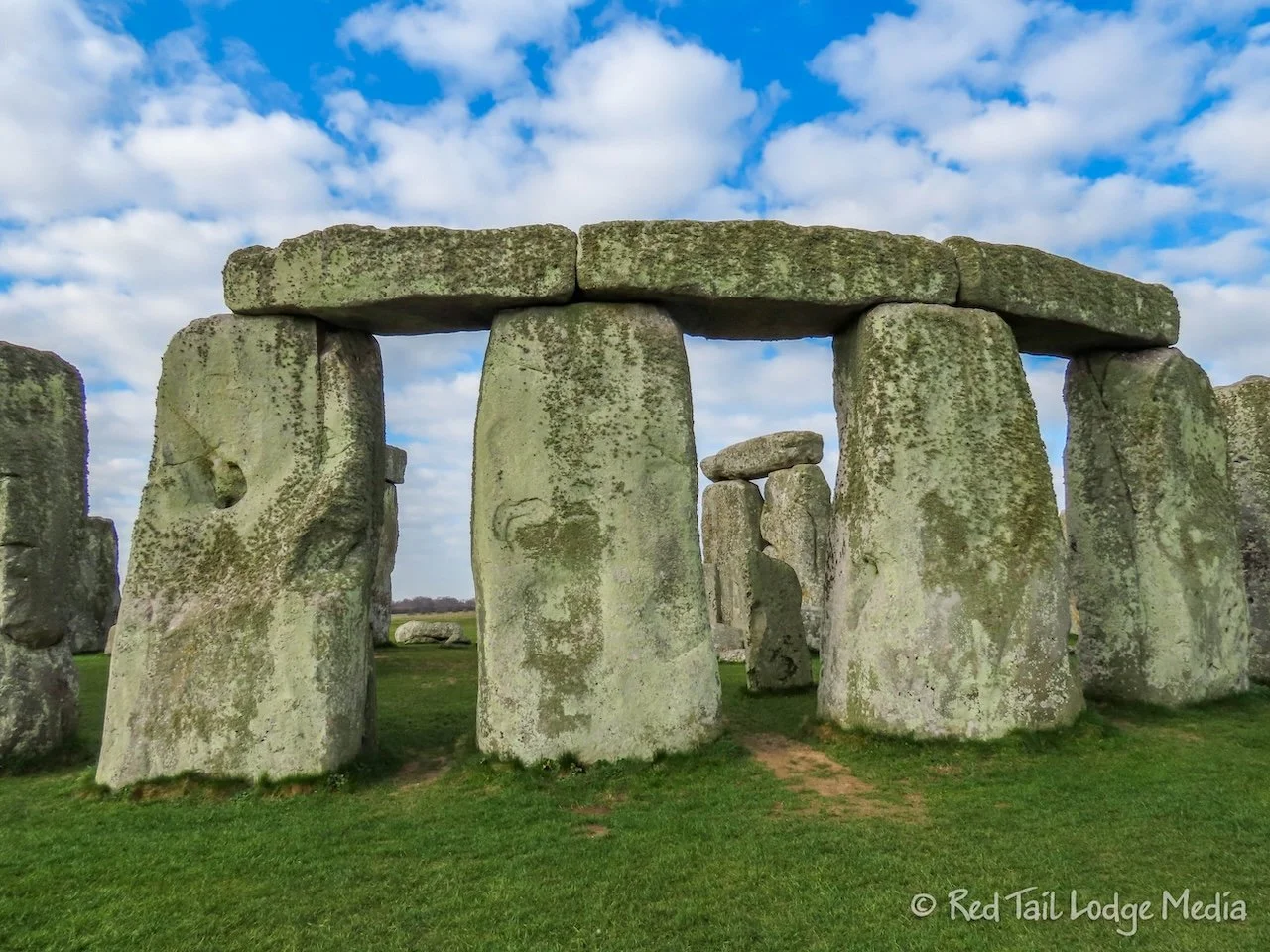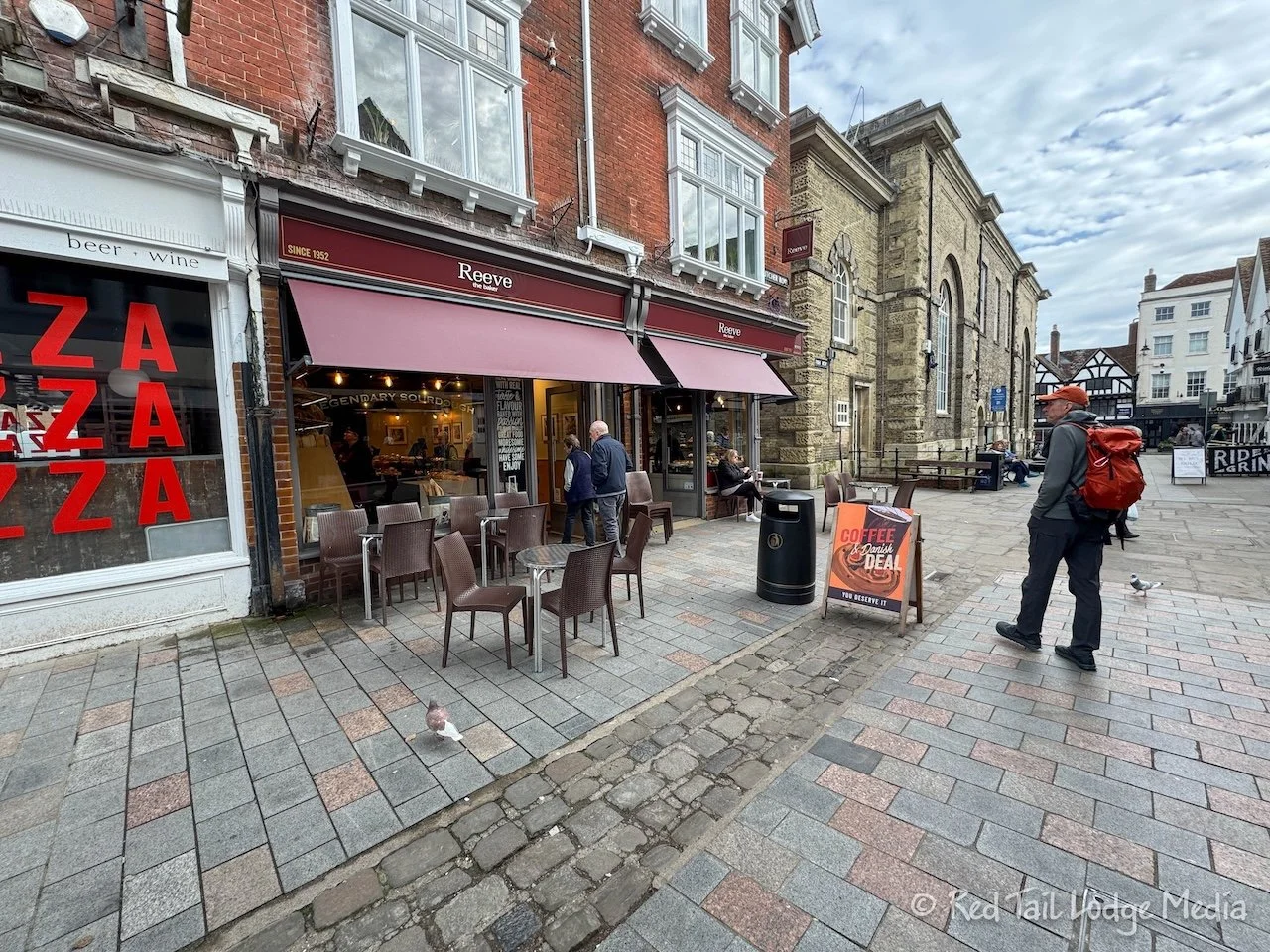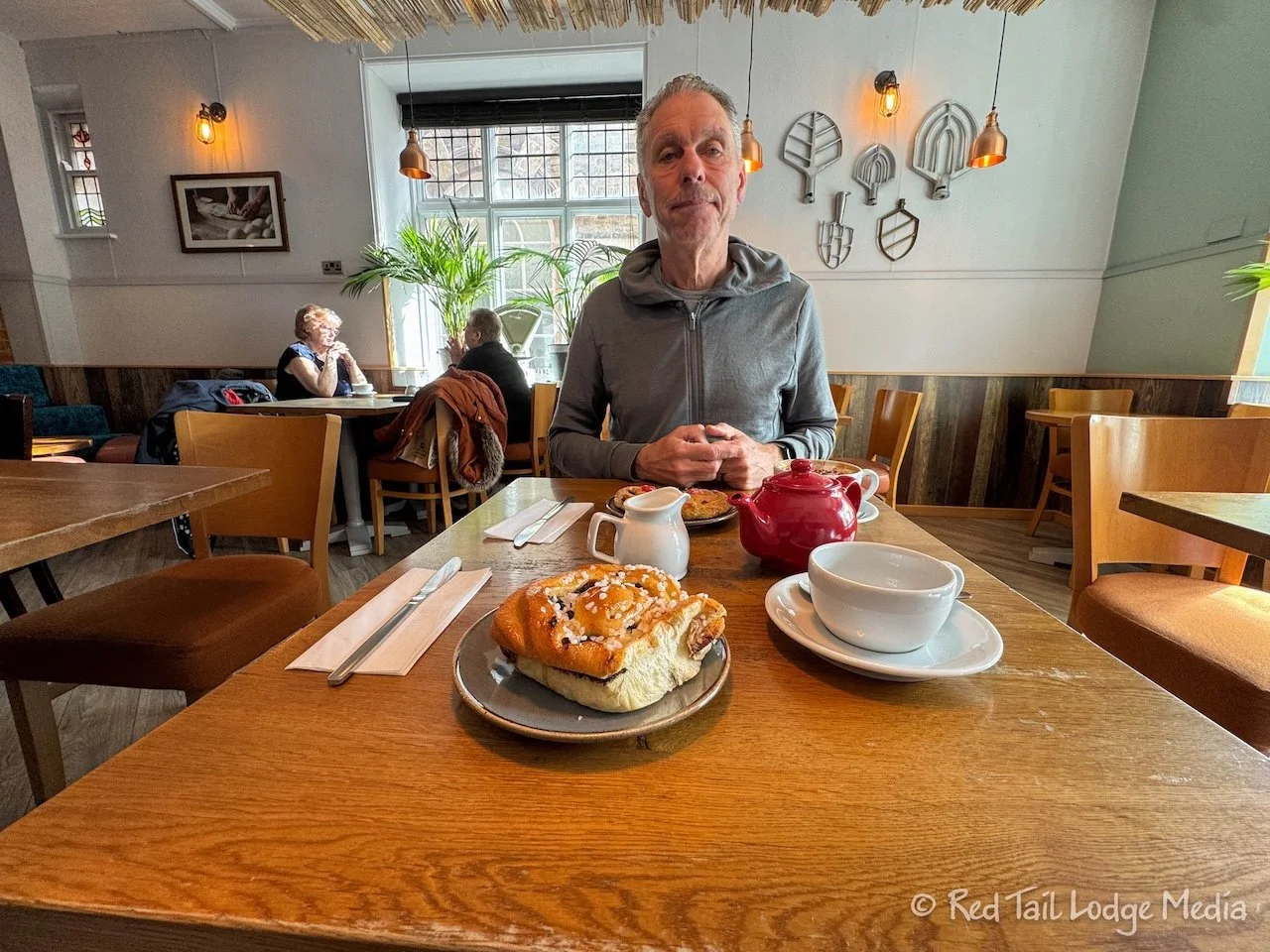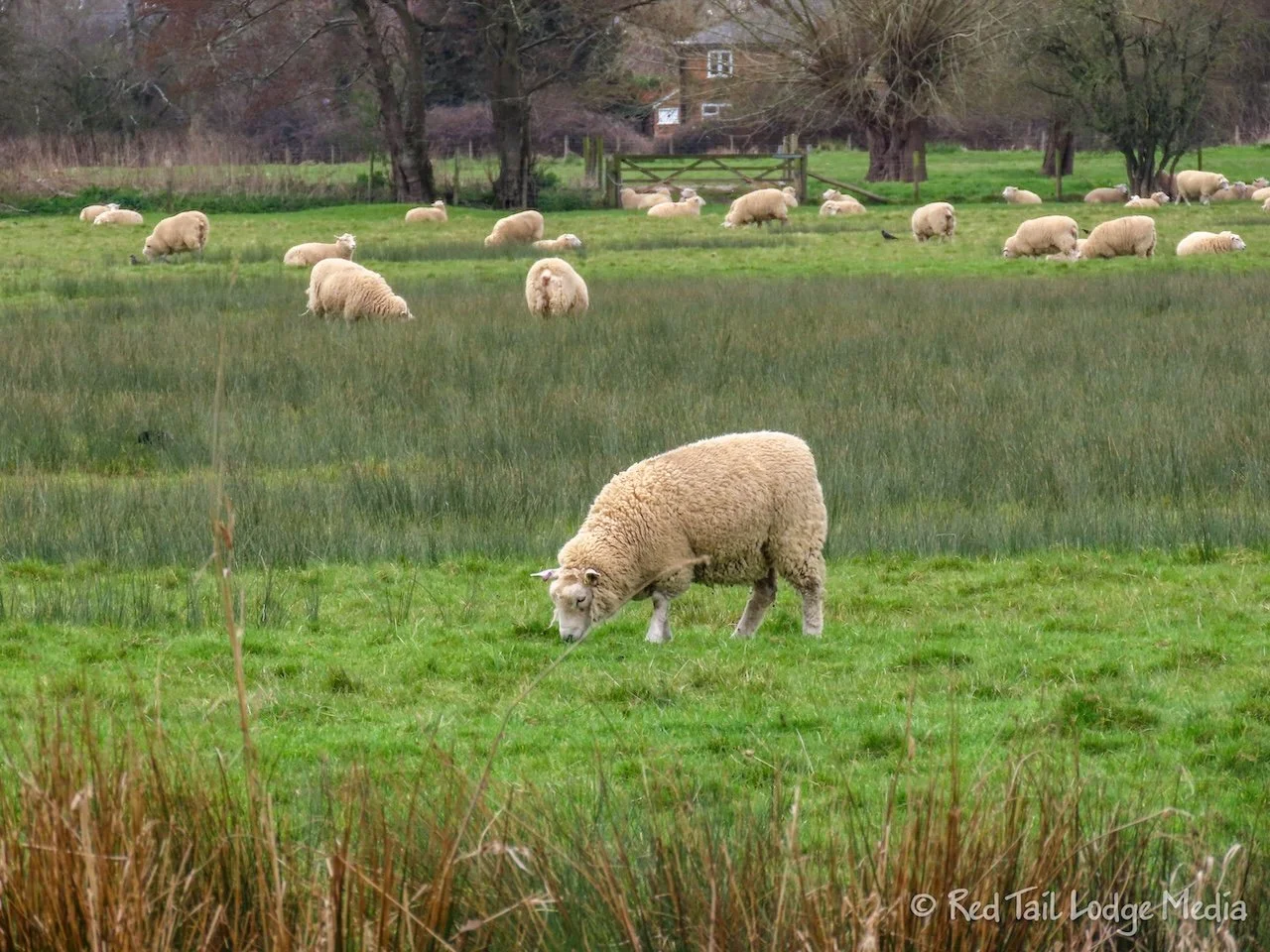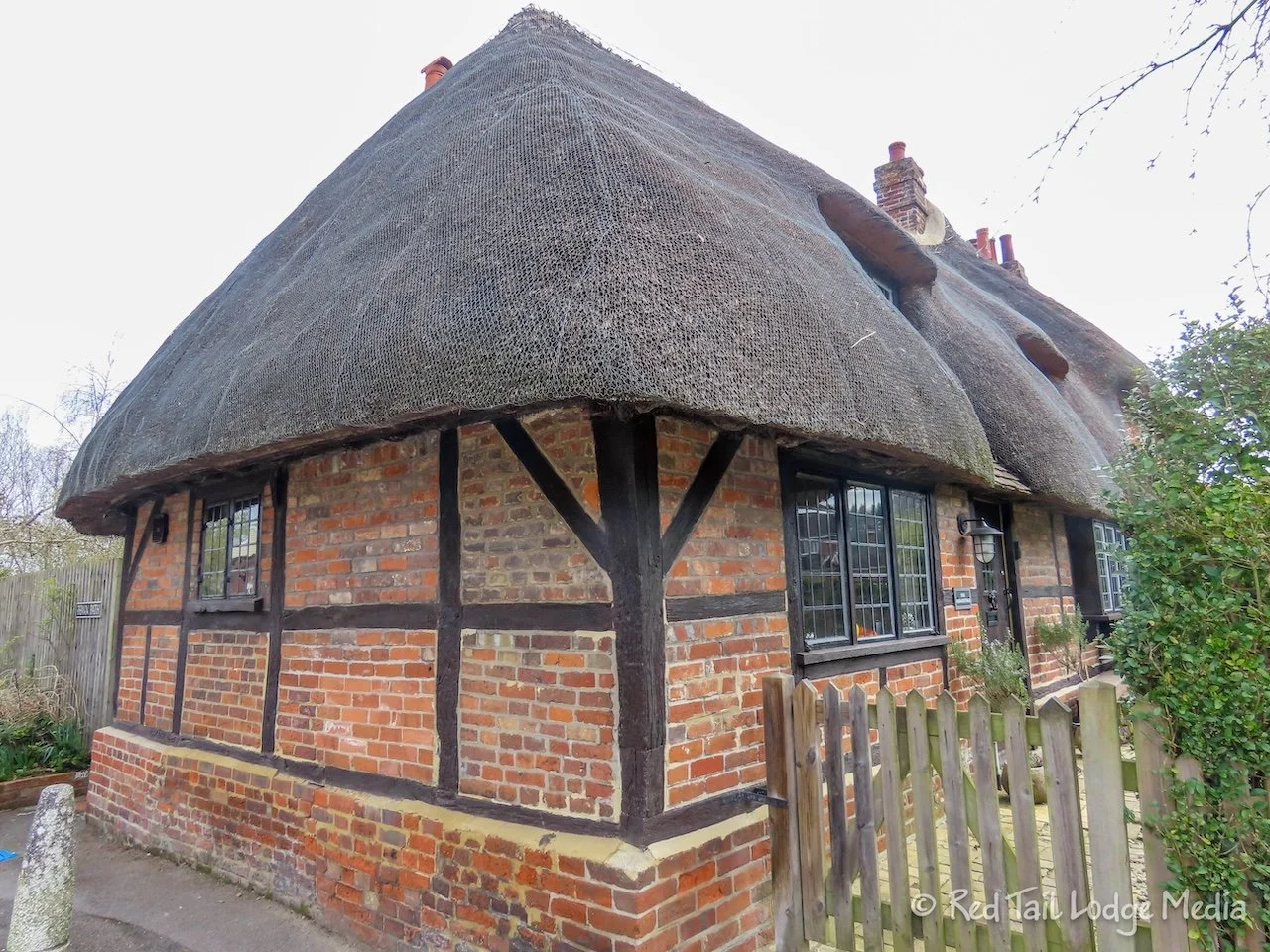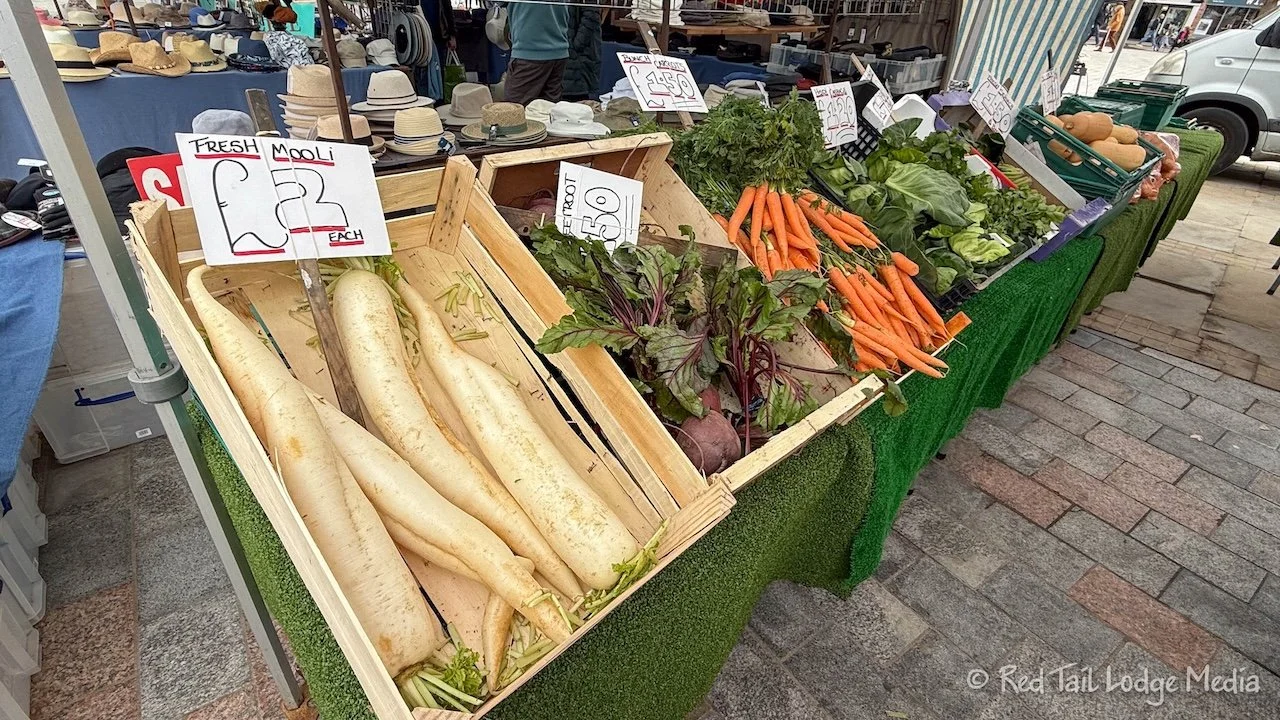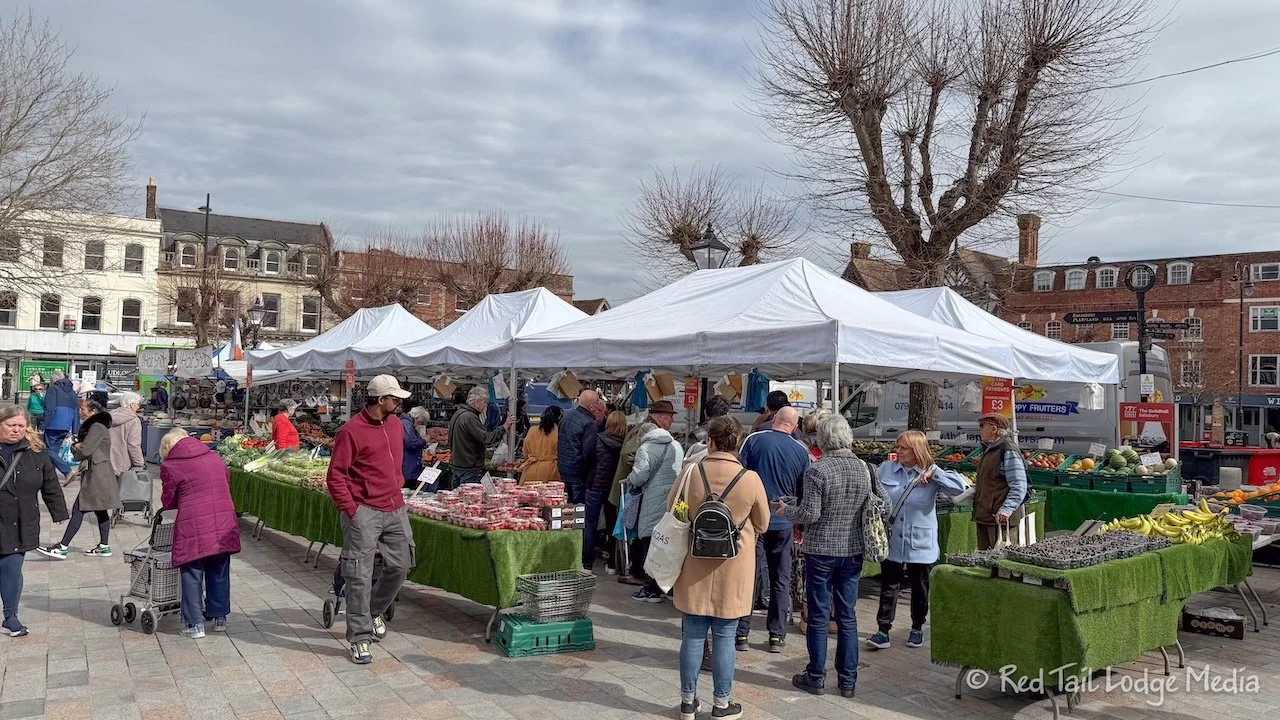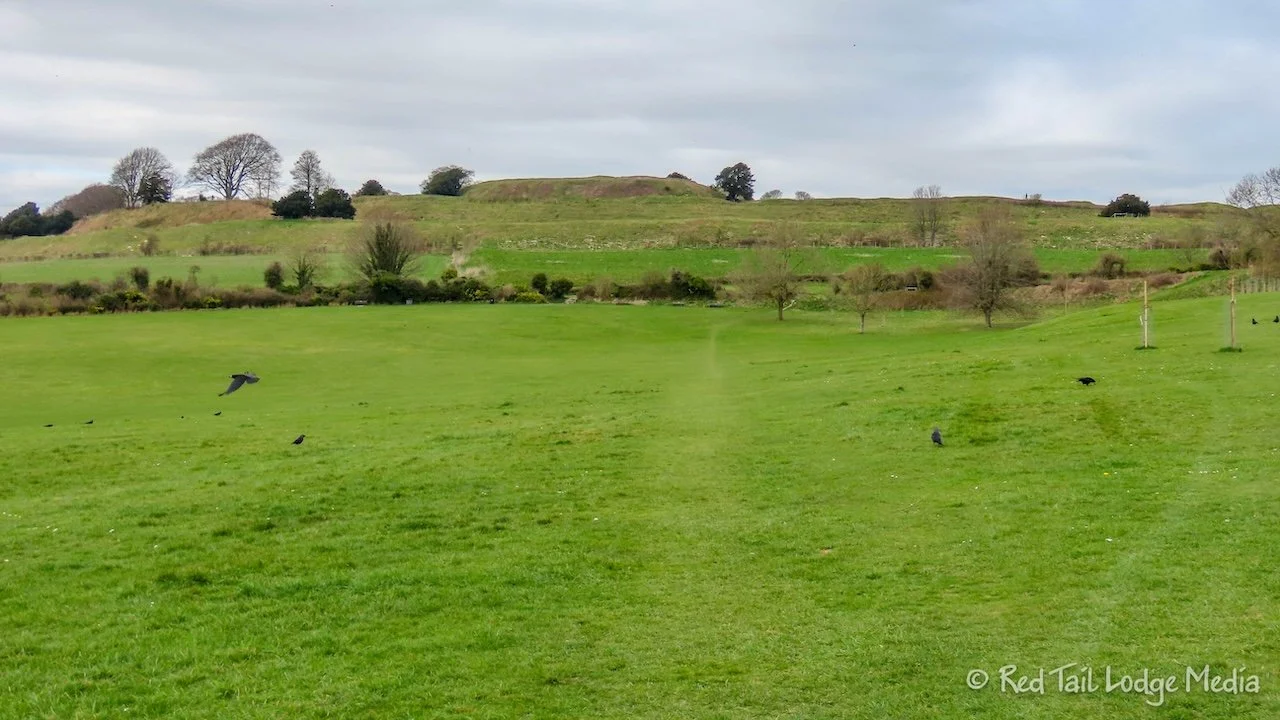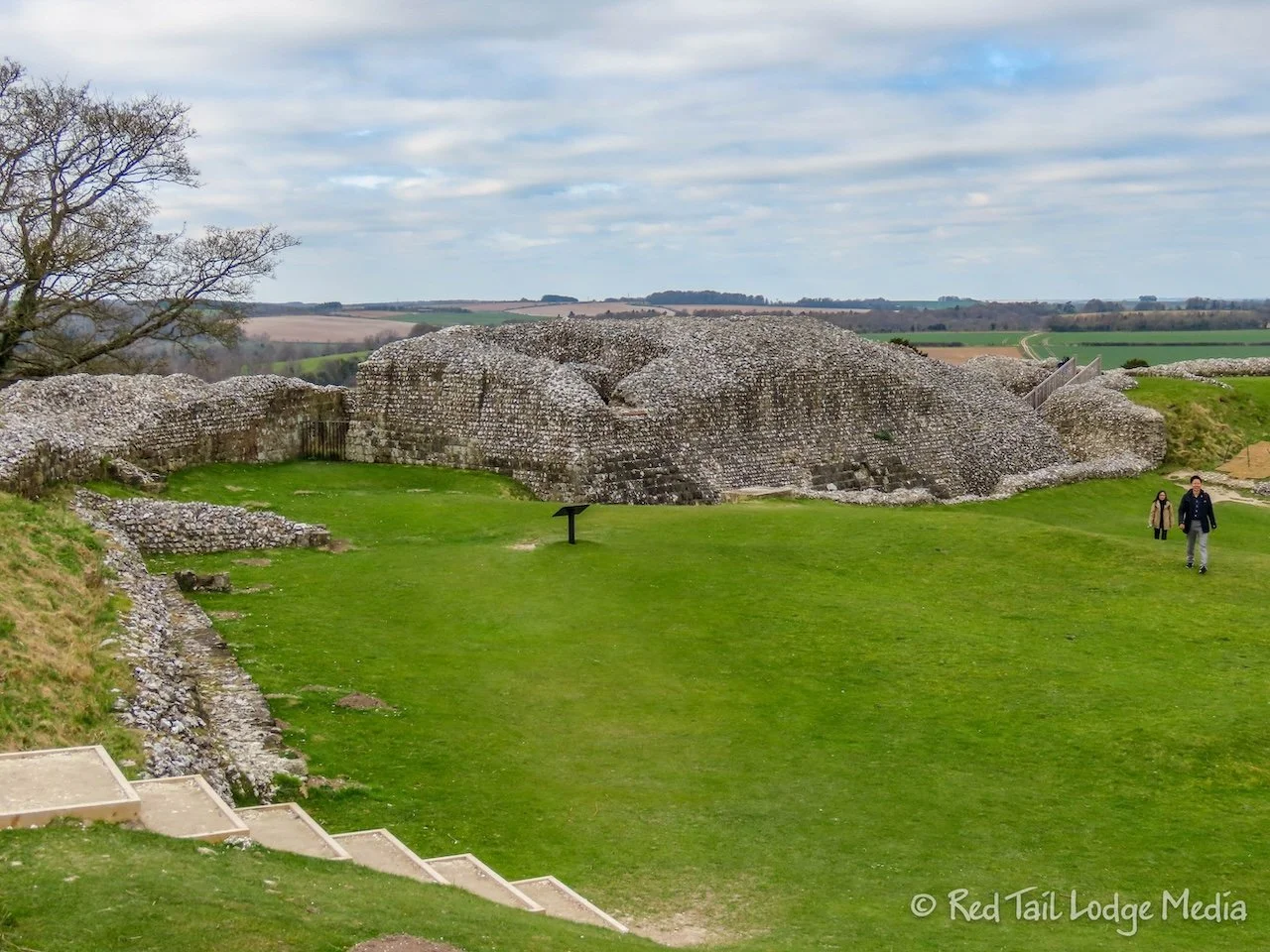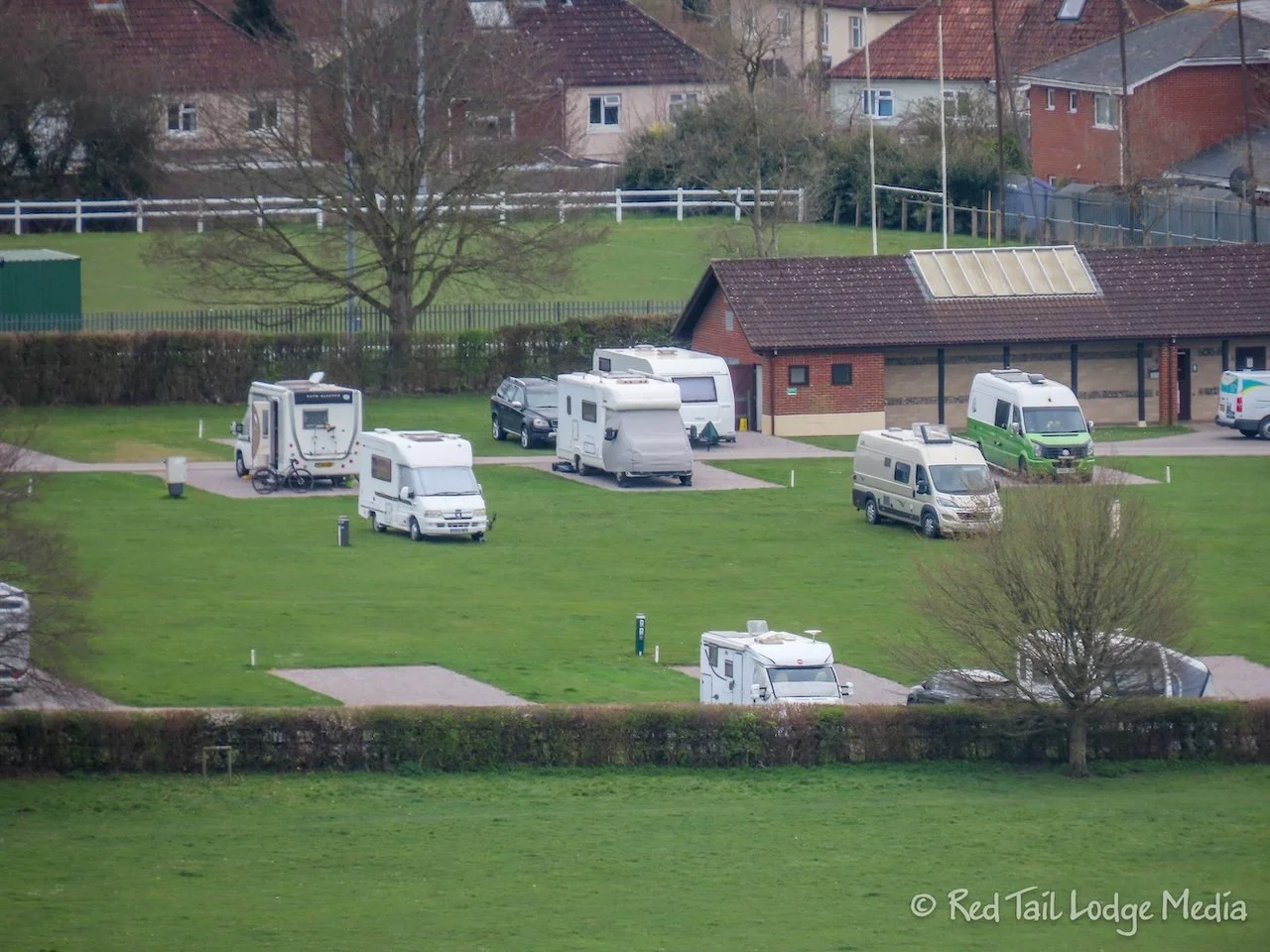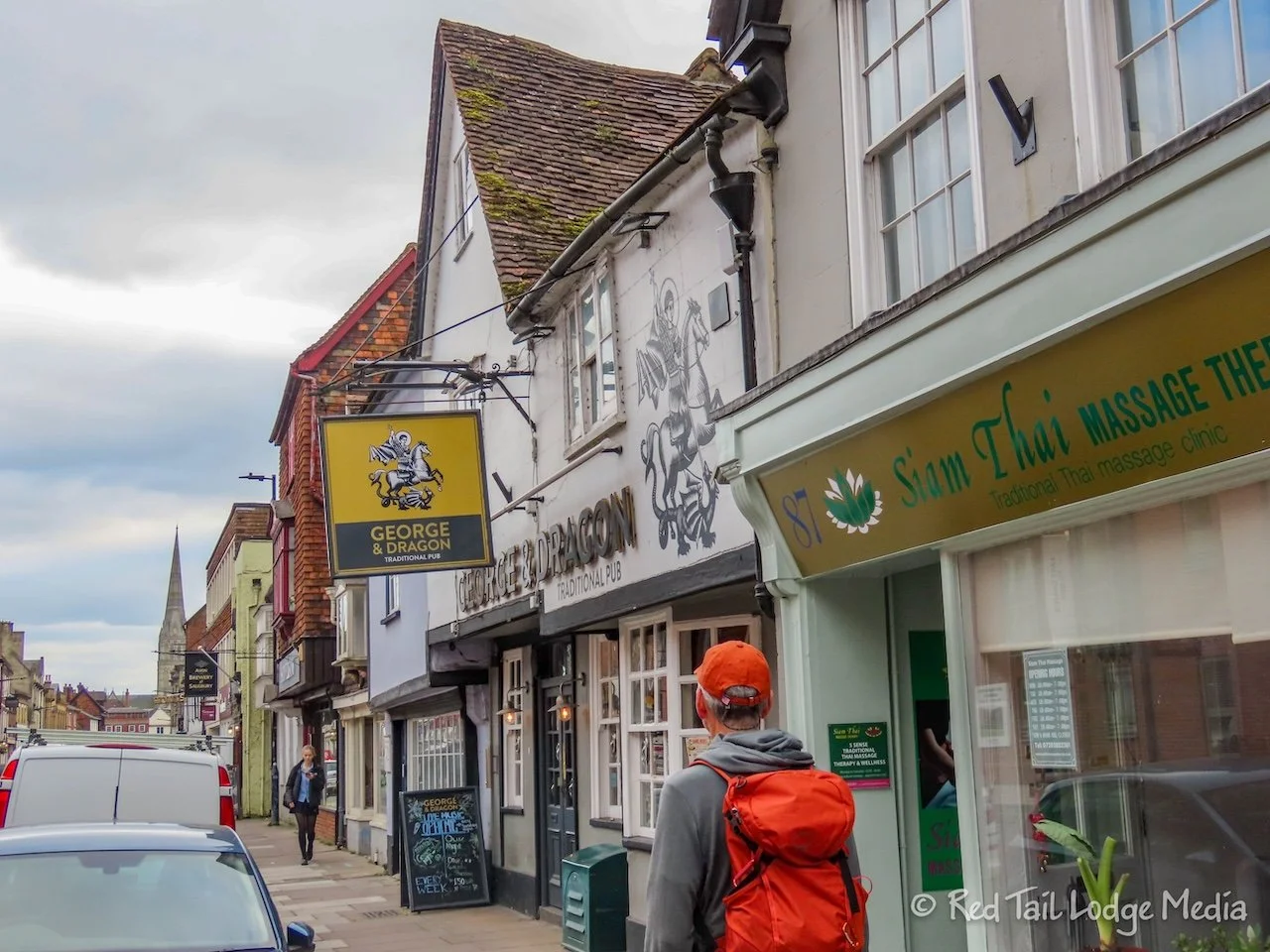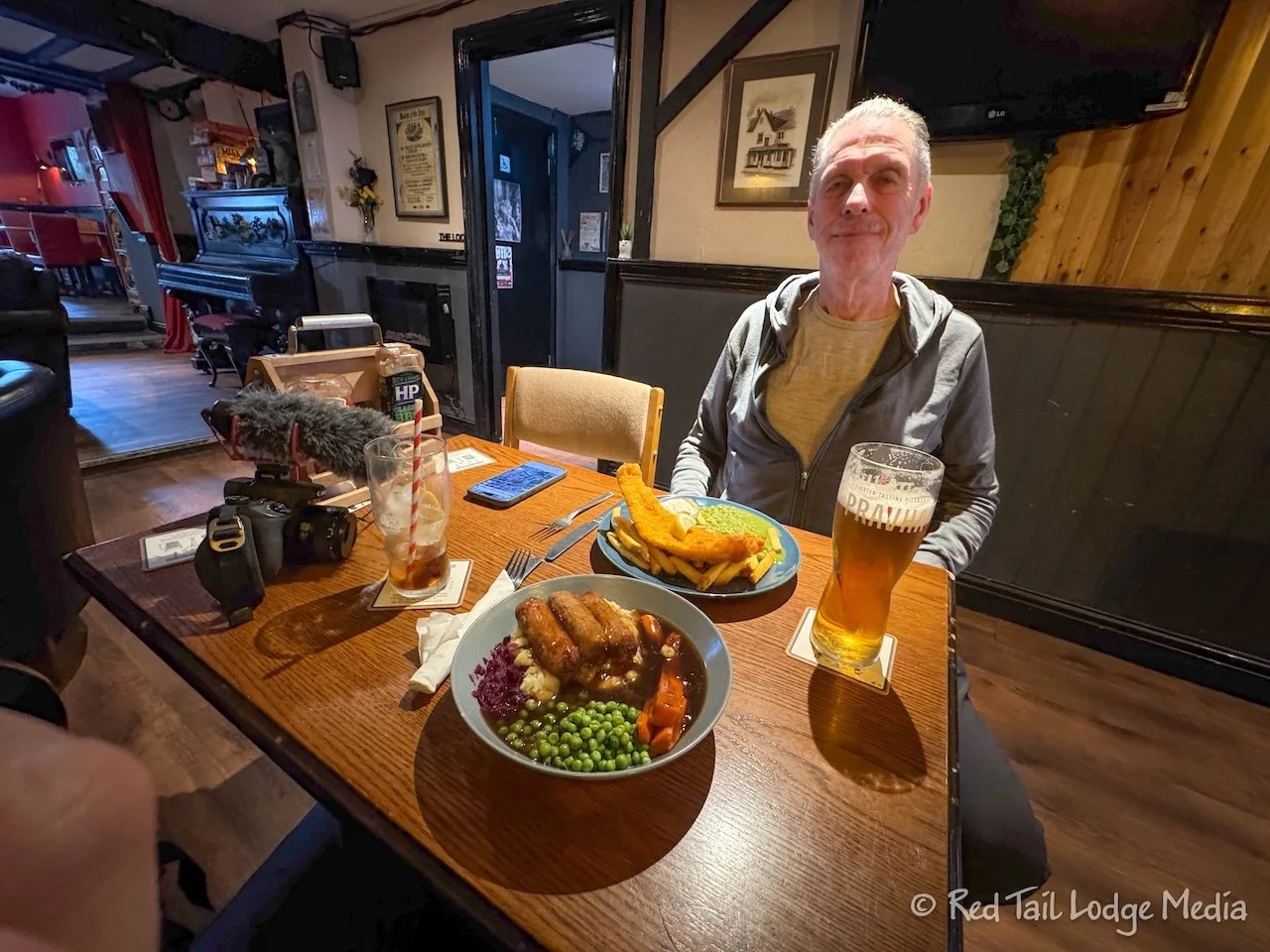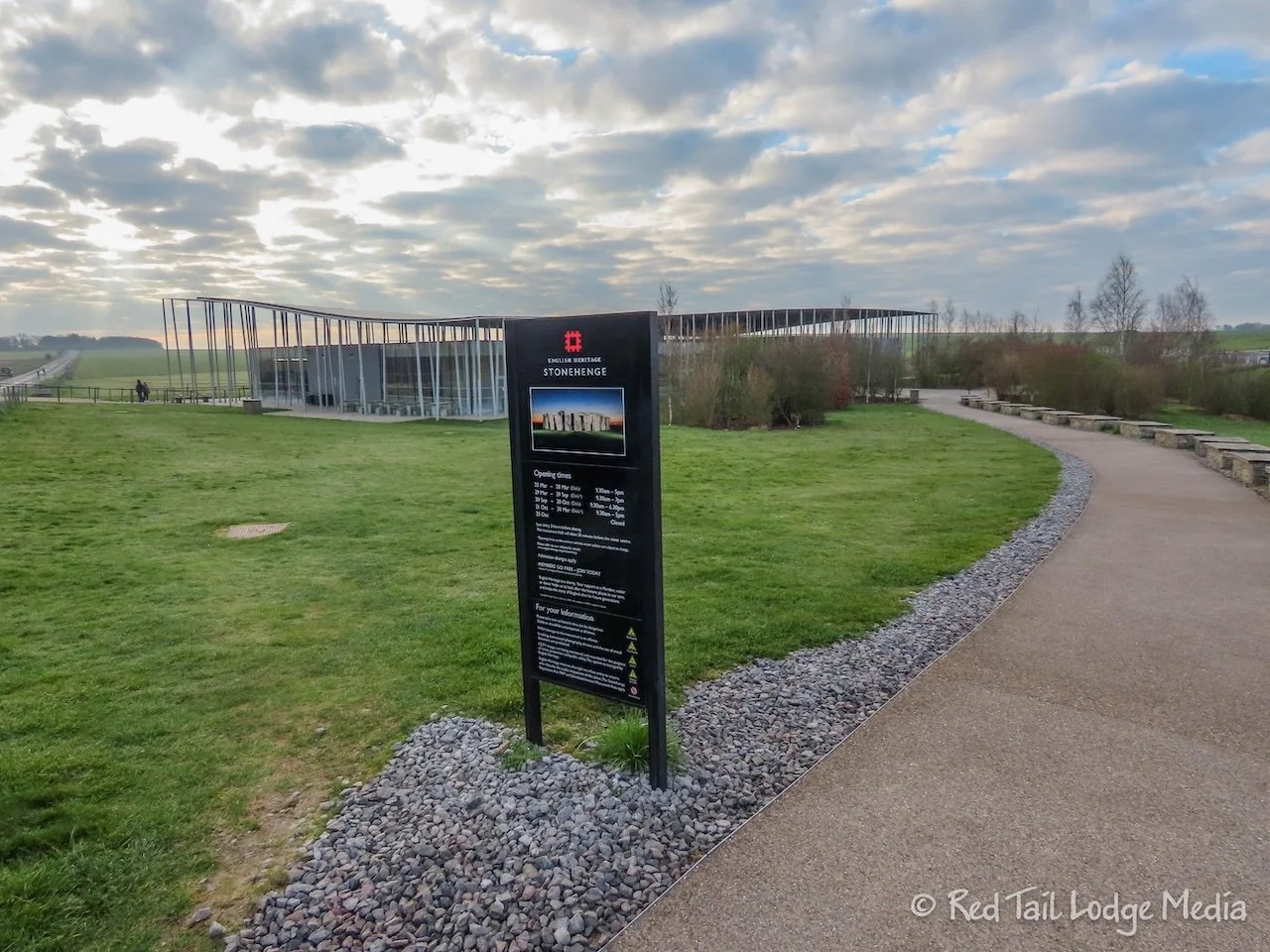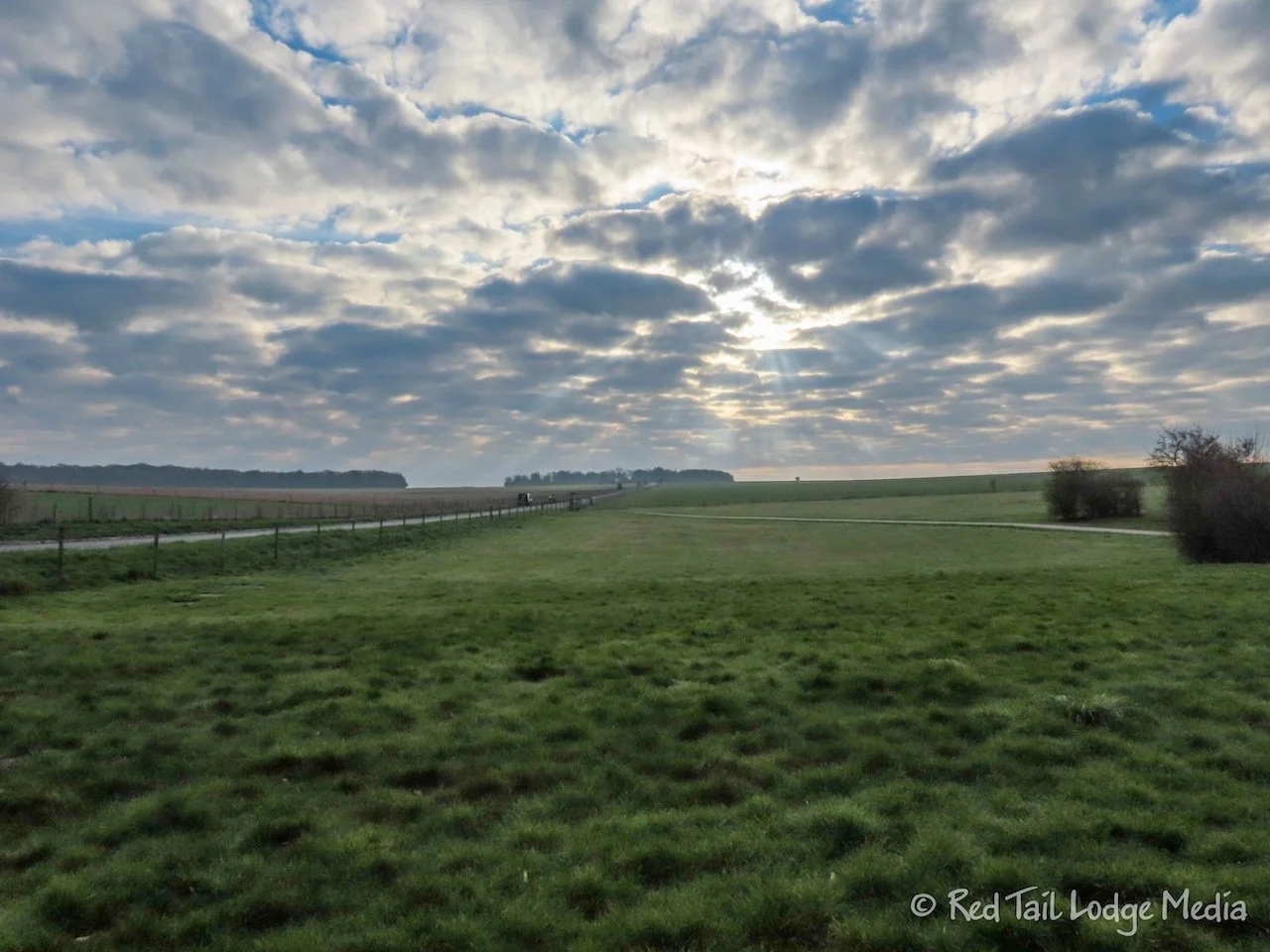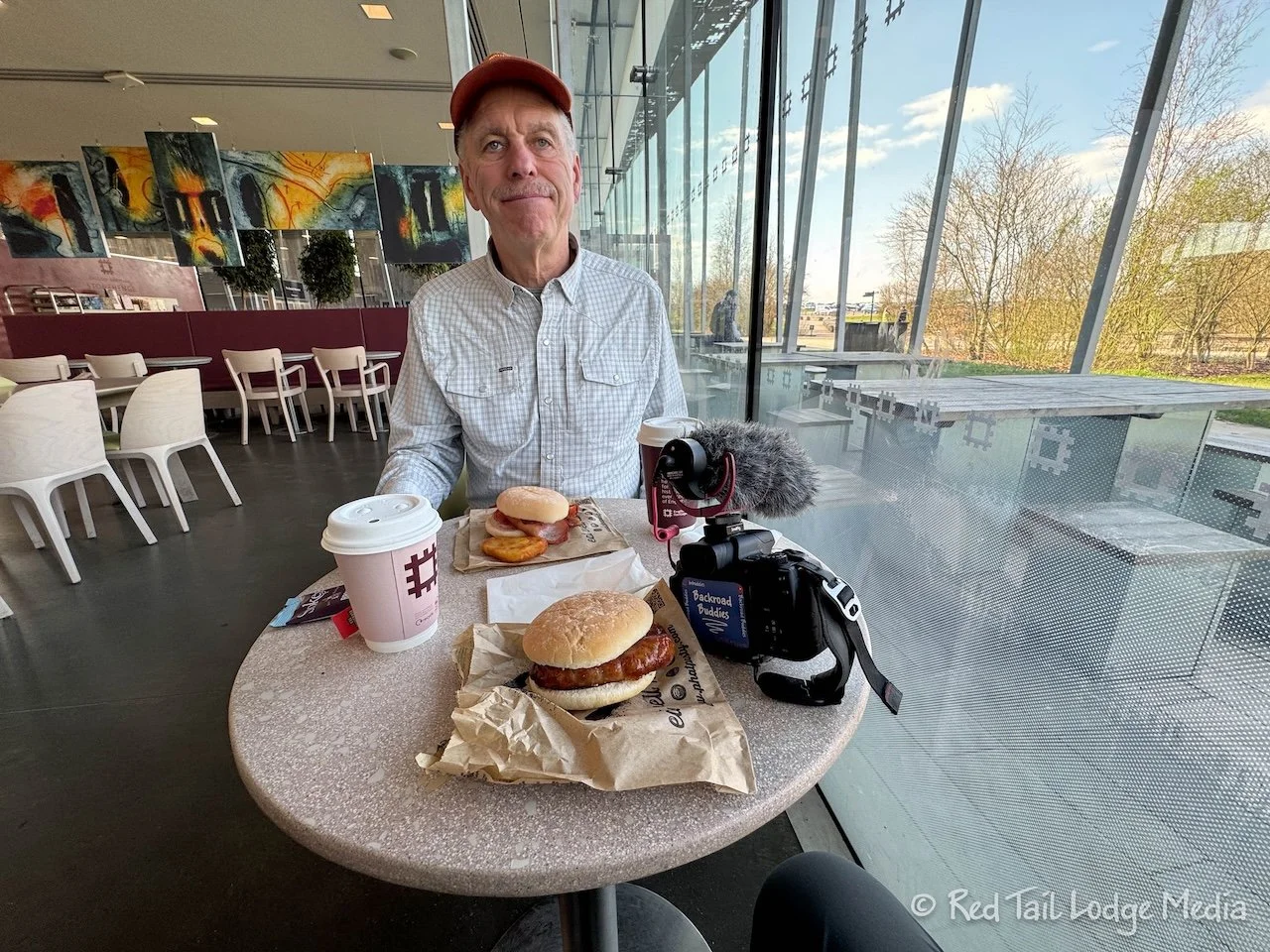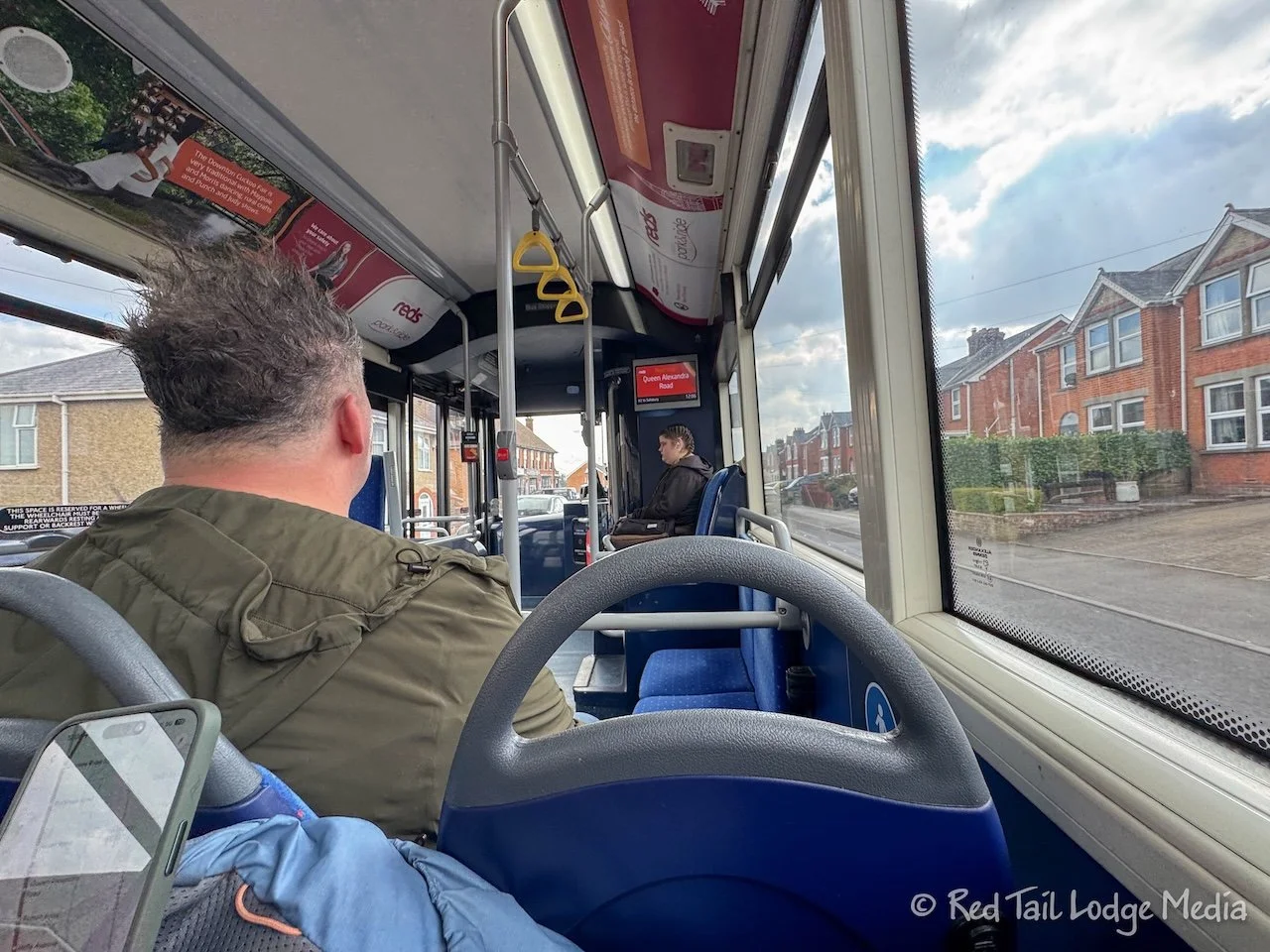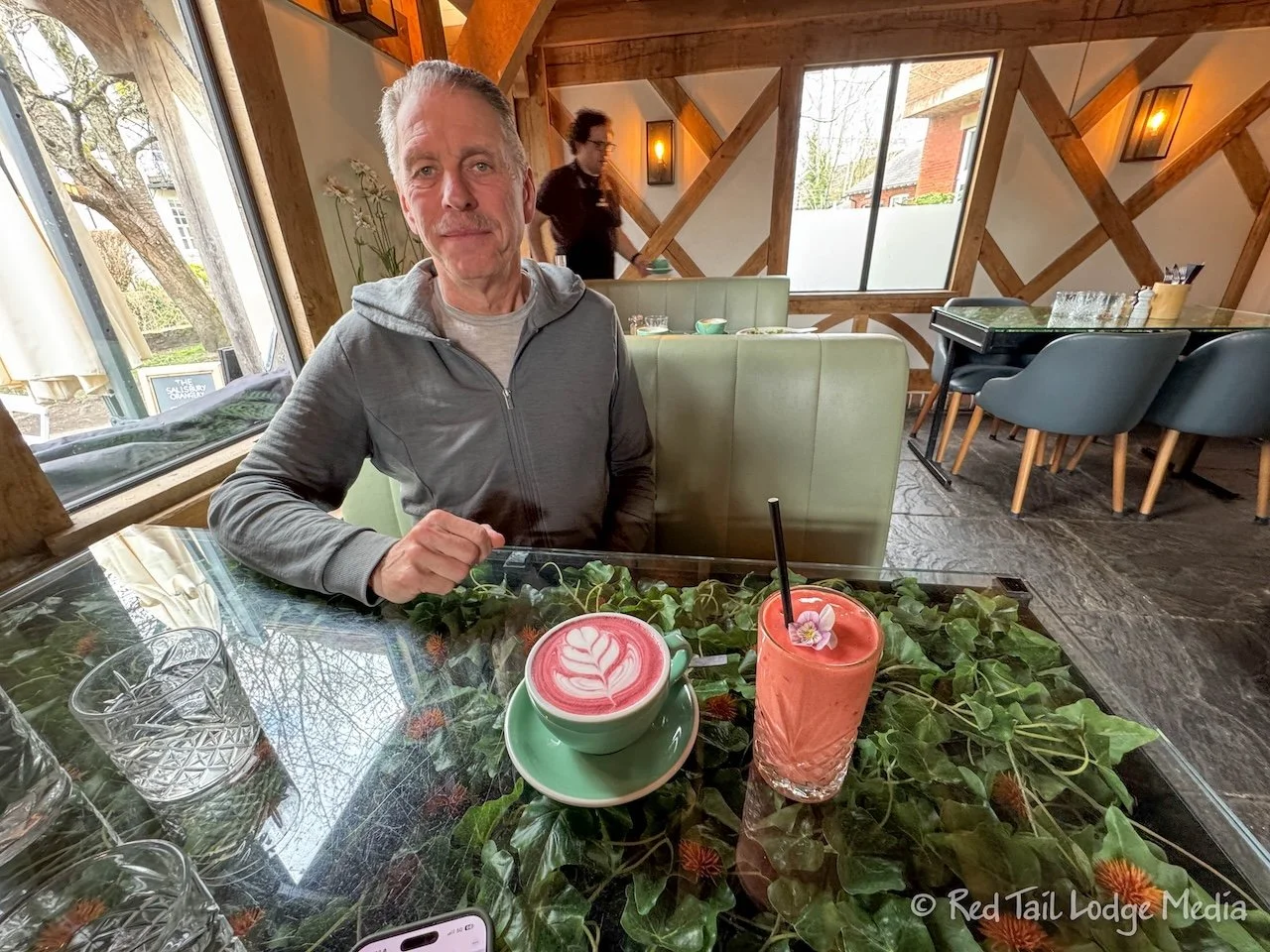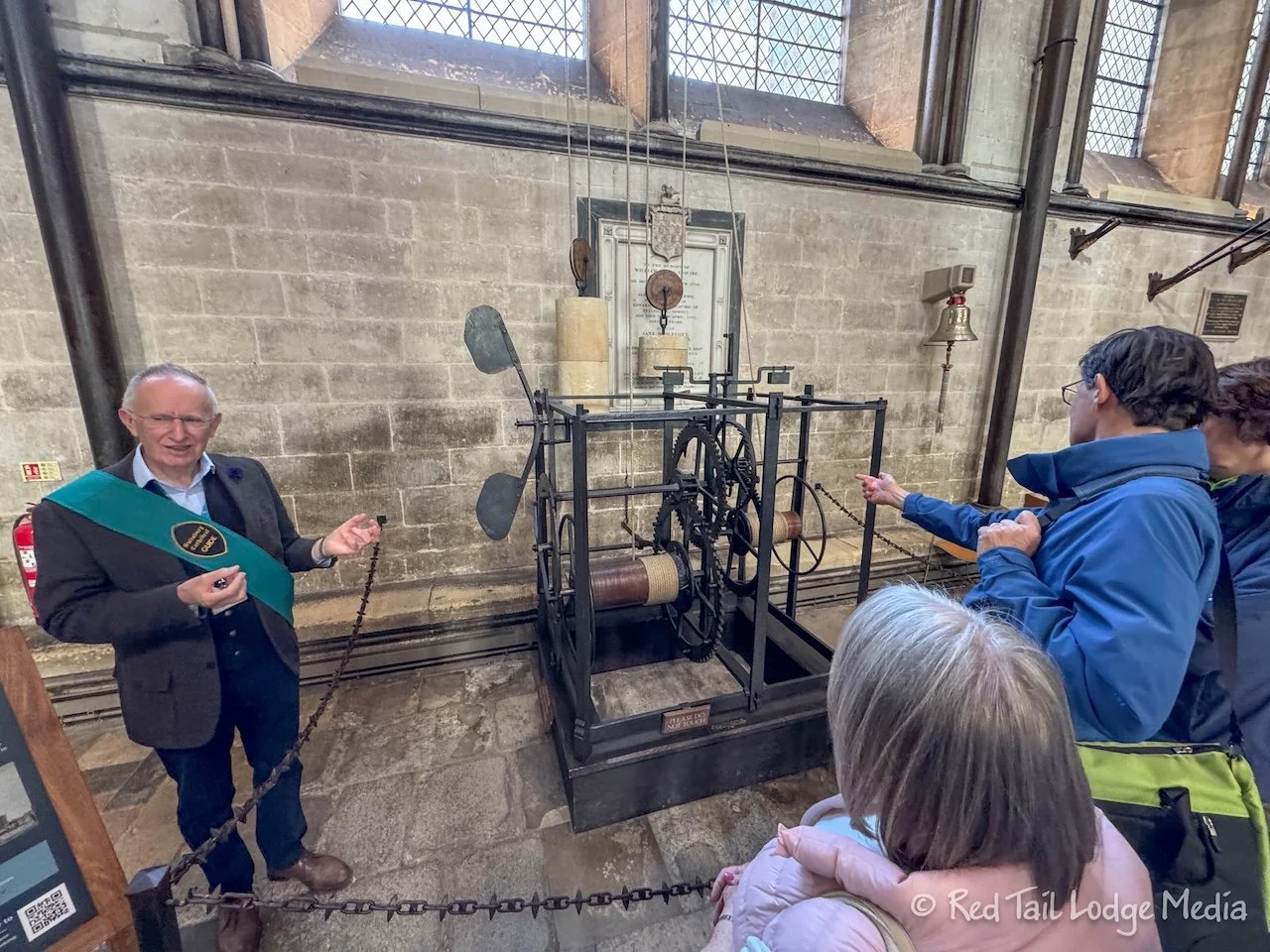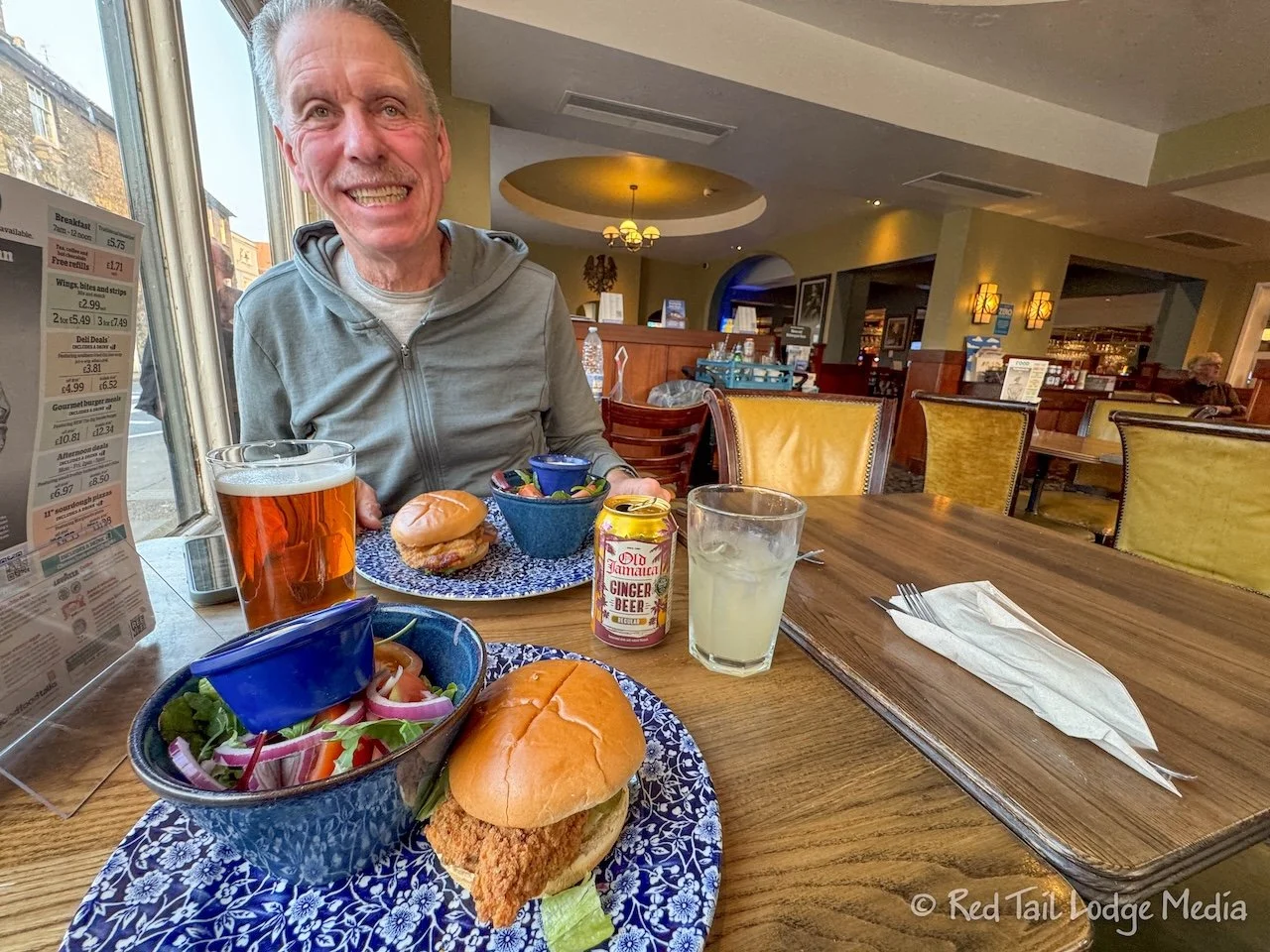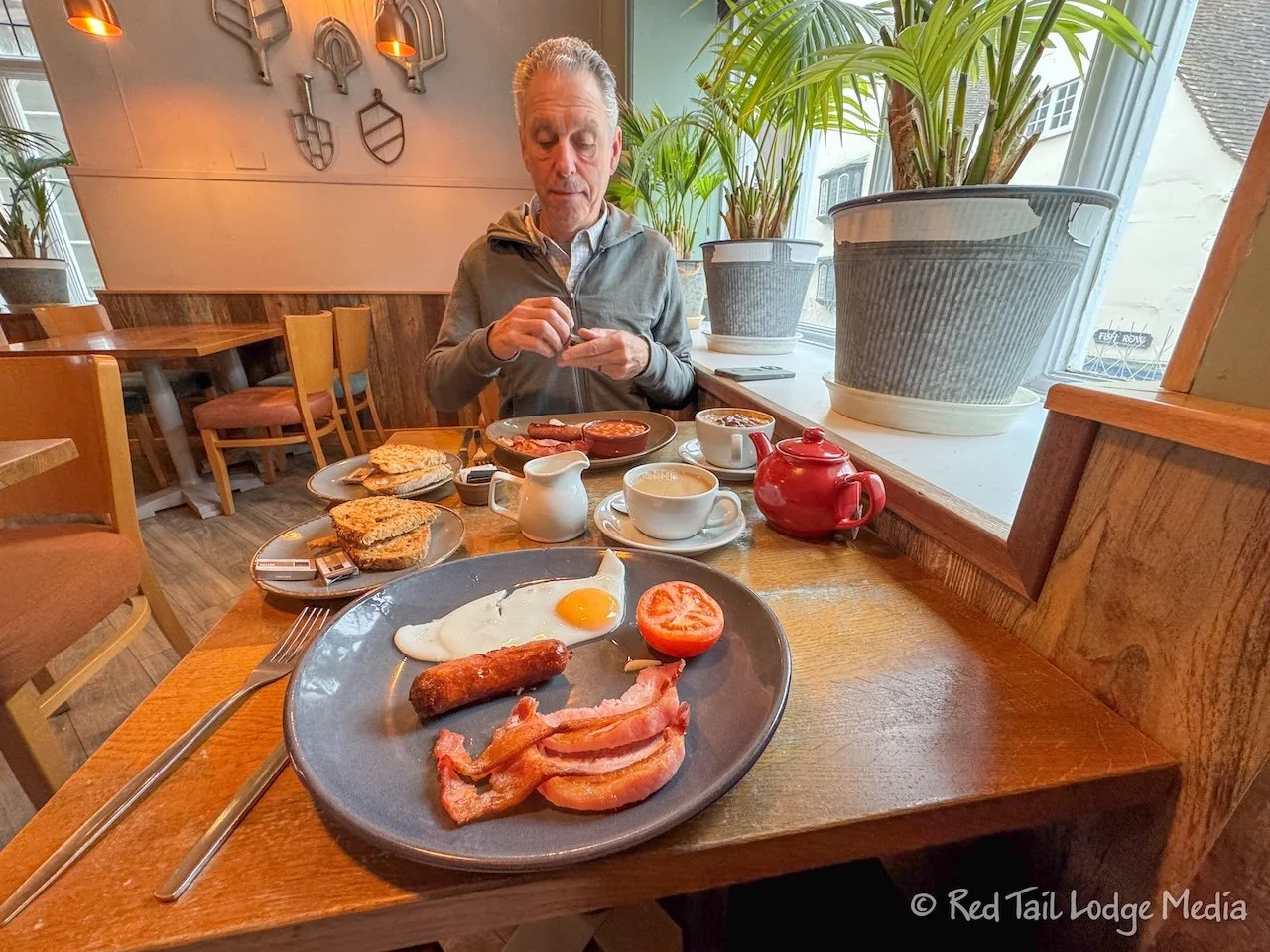Salisbury & Stonehenge, England - March 24th to 27th, 2025
Salisbury England is usually the jumping off point for visiting Stonehenge. However, Salisbury is worth the visit all on its own. This was our first overnight stop in England. We stayed three nights in Salisbury and enjoyed our time there.
Monday, after our treats at Coffee #1 in Southampton, we picked up our luggage and headed back to the Southampton Central train station. It was not even 1 pm (13:00) when we arrived at the station. We had booked a 14:11 train to Salisbury, but our tickets were Evening Out Single tickets. That meant we could take any train along the same route that afternoon. Ann talked to a staff member at the ticket window, just to make sure we could take an earlier train. The answer was yes, and there was a train leaving at 13:11.
The bar codes for our tickets were on our phones. Ann had the tickets in her GWR (Great Western Railway) app, while Keith had a PDF from the email that Ann forwarded to him when she booked the ticket. You need to scan the code at the entrance gate to the train platforms and again at the gates to leave the train platforms at your destination. (Note: your phone needs to think its in the United Kingdom for the GWR app to work. If you have a US phone, you’ll need to use a VPN to change your location to the United Kingdom). In addition, an employee came by while we were on the train to scan our tickets yet again. Since you have to scan before you board and scan when you exit, we’re not quite sure why the scanning while you’re on the train is necessary. That seems like a little overkill to us, but we had no problem complying.
The train ride was only 31 minutes long. When we reached Salisbury, it took us only about ten minutes to walk the 0.4 miles to our hotel, the King’s Head Inn. The hotel is in an old 15th century building in the heart of the city, right next to the River Avon. We were checking in just after 2 pm.
Before dinner, we strolled around the town. The main attraction is the Salisbury Cathedral, with its tower and spire which are the tallest in England. We wandered around the streets, admiring all the old architecture. Then we circled the cathedral, strolling through the surrounding grounds, called the cathedral close, one of Britain’s largest. In one of the grassy fields, a woman’s rugby team was practicing.
For dinner, we went to the Bishop’s Mill, a 1700’s pub across the street from our hotel. Ann had the fish and chips with garden peas while Keith had the lamb hash. To drink, we both had ginger beer. However, Keith’s was the alcoholic version, while Ann’s was the soft drink version. Then we split a sticky toffee pudding with clotted cream ice cream for dessert. It was all very tasty.
We got our first experience of how to order at a pub. You seat yourself at a table and decide what you want to order from the menu. Then you note what your table number is. At Bishop’s Mill, the table number was fixed to one of the corners of the table top. Then you go up to the bar, place your order, tell them your table number, and pay. When your drinks and food is ready, they bring it out to your table. It is our understanding that most pubs operate this way. We’ll let you know later if we find that to be the case or not.
Tuesday, we strolled around the town of Salisbury. We started off the day by having a light breakfast at Reeve the Baker, since breakfast was not included with our room. We had seen the bakery the day before so we wanted to check them out. It was a little confusing, because as we headed down the street to where we remembered it being, we came across it on the other side of the road, looking much smaller than we recollected. Surely, that’s not the same place. So we continued down the street another block, where we found a second one, on the side of the street we thought it was on and much bigger than the first one. We not sure why there are two locations so close together.
The bakery was two stories, with the second story being a small cafe. We went upstairs and got a table. Ann ordered the tea with a Chelsea bun, while Keith had a cappuccino and a Sultana Danish. A Chelsea bun is similar to a cinnamon bun. It is a type of currant bun that was from the 18th century, started by the Bun House in Chelsea (an area in London). Sultana Danish is a puff pastry with sultanas, a type of raisin. Since we were in England, Ann added milk to her tea. It was a lovely way to start the morning.
From there, we went next door to the Salisbury Visitor Center. We had tickets for the early morning Stone Circle Experience the following day. Our scheduled arrival time was 7:45 am, but that is before any buses start running. We needed to figure out how we were going to get there, since we didn’t have a car.
The person at the Visitor Center that we talked to was very friendly and helpful. She recommended calling a taxi and taking a regular city bus on the way back. When most people visit Stonehenge from Salisbury, they take the Stonehenge Tour, which runs buses between Salisbury, Stonehenge, and Old Sarum. You have the option of just paying for the bus ride, adding on the admission for Stonehenge and Old Sarum, or buying the all inclusive ticket which includes admission to Salisbury Cathedral (which is valid for 48 hours after your tour). But those buses only run between 10 am and 5 pm. Our Stonehenge ticket was for a special admission outside of normal visiting hours.
The Visitor Center provided us a taxi phone number to call and also informed us that there is a taxi stand just one street over from the Visitor Center. We went to the taxi stand and talked to a couple of the drivers to arrange a pickup the following morning at 7 am.
The nice woman at the Visitor Center also gave us a walking map of the area and some suggestions of what to see. In the morning, we walked the Town Path through the Harnham Water Meadows over to Harnham Road, circling back around to Exeter Street. The Harnham Water Meadow is where the River Avon and River Nadder blend together. The meadows are filled with grazing sheep, among the different water channels and boggy grasses. Beautiful swans glided down the rivers and waterways. Birds sang cheerfully in the trees.
On the far side of the meadows was the Old Mill. Also on the far side of the meadows, cute cottages lined the streets, some with thatched roofs. We passed through a park with a cricket pitch to reach Harnham Road. Exeter Street runs alongside the Cathedral Close before returning us to the Market Square.
The Salisbury Charter Market is held every Tuesday and Saturday. It has been running since the year 1227. Since it was a Tuesday, we were able to explore the market and find some lunch.
Ann decided to try a pasty from Shelleys Bakery. They were out of the traditional Cornish pasty, so she opted for the one with beef and veggies, which was similar. The Cornish has beef, potatoes, swede (turnip), and onion. From what Ann could tell, the only difference was that hers had carrots instead of swede. Meanwhile, Keith ordered the Fake Duck with hoisin sauce and spring onions (green onions) from a vegan food truck. The Fake Duck was on top of a bed of sweet potato fries. Ann liked Keith’s meal better than her own, but Keith only allowed her to have one little taste.
We talked with the food truck staff on what the Fake Duck was made from. It turns out that it was just flour, water, and salt, but the process takes many hours. The dough is boiled in vegetable broth, worked, stretched, and braided. Somehow the lengthy, complicated procedure turns the dough into a texture that closely resembles shredded meat. Unbelievable!
In the afternoon, we decided to walk all the way to Old Sarum. Since we’ll be taking the city bus back from Stonehenge the following day instead of the tour bus, we won’t be stopping at Old Sarum on the way back. Old Sarum sits on top of a hill, less than three miles from the center of Salisbury.
Old Sarum is the location where the 11th century Old Sarum Castle once stood. A royal palace was built inside the castle for King Henry I. Outside the castle was a cathedral. The castle and cathedral were abandoned as the new cathedral in Salisbury was being built, starting in 1220, and most of the community moved to Salisbury. Only the foundations of the castle and the original cathedral remain.
It was a nice walk to Old Sarum. We started out on the River Walk along the River Avon. Then we headed up Castle Road, through a couple of parks before cutting across the meadows of Hudson’s Field to reach the hill. The only unpleasant part was when we were right next to the road, since Castle Road is a busy, noisy road.
We did find a few points of interest along the way, at least they were interesting to us. First was Secret Spitfire Memorial next to the Salisbury Rugby Football Club. During World War II, Salisbury built almost 2500 Spitfires in total secrecy after the Spitfire factory in Southampton was destroyed.
Near the memorial, a sign for a raw milk vending machine caught Keith’s eye, so he had to go over to check it out. The vending machine dispenses dairy products, such as eggs and yogurt. In addition, you could purchase empty liter and half liter milk bottles. Then you can fill up the milk bottles in another vending machine.
Another sign caught Ann’s eye, one for a campground, the Salisbury Camping and Caravanning Club Site. Since we are RVers, we were curious what an English campground looked like. The first small area looked like a parking area with no hook ups. Then a little further down was a much larger area with hook ups. We didn’t venture all the way to the second area, so we’re not sure if the hook ups were just electric or also included water. From what we have heard, cassette toilets are the norm in Europe, so we’re pretty sure the campground didn’t have any sewer hookups. We were impressed at how nicely spaced the camp sites were, although there was not any privacy between sites.
The admission to Old Sarum was 7.45 pounds per adult (currently, one pound is about $1.30). It didn’t take too long to get our fill of looking at the ruins of the Old Sarum, as not much remains.
After touring the castle and cathedral ruins, we took a slightly different route on the way back to Salisbury, avoiding Castle Road. We crossed more meadows, with hedge rows and horses, before crossing through some quiet neighborhoods to return to the River Avon. Along the river, we went through some woods, with the sounds of birds surrounding us.
A few blocks before reaching our hotel, we stopped at George and Dragon on Castle Road for an early dinner. As soon as we entered the pub, the bartender was quick to tell us that they were doing table service that evening, meaning he would come to our table to take our order. This time Keith had the fish and chips, with mushy peas, while Ann ordered the trio of sausages. We’ve never had mushy peas before, so Ann tried a bite of them as well. They tasted just as we would expect mashed up peas to taste like. They seem to be popular in England. Mushy peas were on the buffet every day on our transatlantic cruise. Can’t really say it would be something we would ask for again. Ann’s sausages came with mashed potatoes, carrots, garden peas, red cabbage, and gravy. It was a very filling meal. To drink, Keith tried a Czech beer called Pravha by Staropramen, a light pilsner.
The pub was not busy, so the bartender chatted with us for a while. His partner was from Tennessee, so he was interested in learning about places to visit around the United States. Keith asked him about the protocol of passing other pedestrians on the sidewalk. He was curious if people expected others to stay to the left, similar to how they drive on the roads, because we had been experiencing a mixture as we walked around town. His reply was that there was no normal, especially in London, because they stand on the right on escalators and move off to the right when queuing up. So you can encounter a mixture of which side to walk on.
From our hotel to Old Sarum and back to George and Dragon, we covered 6.1 miles with an elevation gain of 712 feet in a little over three hours, including our tour of Old Sarum. It was hike number two of our 52 Hike Challenge for 2025. Our first hike was back in February when we were in Keystone, Colorado.
Wednesday, we got up at 6 am and the taxi picked us up in front of our hotel at 7 am. It was about a 20 minute ride to the visitor center at Stonehenge. The taxi cost us 25 pounds (23 pounds plus a tip). We arrived before the main gates were open to the parking lot, but the guard at the gate looked up our name on his list and let the taxi through.
In 1977, Stonehenge stopped allowing free access inside the circle due to damage erosion of the ground near the stones from so many visitors. For an extra fee (70 pounds per adult instead of the normal general admission of 30 pounds), you can reserve a spot with the English Heritage for the Stone Circle Experience. There are a limited number of time slots before and after normal visiting hours which allow people to go inside the stone circle. We had an 8 am time slot and there was another group before ours. If you are planning on visiting more English Heritage sites, you might want to check out getting a membership for the year to see if you’ll save money by going that route.
We arrived about half an hour early, so we wandered around the displays outside the visitor center while we waited for our shuttle bus. There were about 25 to 30 people in our group and about the same number of people in the previous group.
Our guide was sure to inform us of the rules. No touching, kissing, licking, kicking, stepping or standing on the stones. And no taking off all your clothing and running naked through the stones (yes, apparently that has been a problem in the past).
When we arrived at the stones, we were given a few minutes to take pictures of the stones without anyone inside the circle. Then we were led into the circle, given some interesting facts about them, then allowed to wander around the stones on our own until our hour was up.
The stones were erected in stages, between 3100 BC and 1600 BC. It is believed the builders picked this spot due to the heel stone, a large upright stone placed there by nature, not man, probably from a glacier. Thousand of years before Stonehenge, many cremated remains were buried in the area, having been transported from hundreds of miles away.
Some of the stones at Stonehenge are two upright stones with a horizontal stone across the top. There are bumps on the vertical stones that line up with the carved out cavities of the horizontal stone, so they fit together like Legos.
There is a stretch of vertical stones, all connected together with horizontal stones across the top, with the horizontal stones chiseled into shapes so that the horizontal stones fit together like a jigsaw puzzle.
While we were admiring the stones, a large bird just outside the circle caught Ann’s eye. It was a bird she had never seen before. Our guide informed us that it was a Great Bustard. They had gone extinct in England in the 19th century, with the last bird being shot in 1832. Since 1998, they have been reintroduced to England on the Salisbury plain.
According to our guide, this particular bird was a female who spends most of the year with a male and another female. However, during mating season, she leaves the mating pair and hangs out near the stones for a month, as she doesn’t have a mate. She’s been returning every year for the past ten to eleven years now.
After our time was up, we decided to walk back to the visitor center instead of riding the shuttle bus. There were several paths, with the shortest one being about 2 kilometers. It was a lovely stroll through meadows and woods, with some burial mounds, or barrows as they called them, along the way.
As we were going through the woods, a beautiful pheasant scurried across the path in front of us, but it was too fast for Ann to get a good picture.
Back at the visitor center, we went into the cafe to grab a bite to eat. It was almost 10 am and we hadn’t had anything to eat yet. At the cafe, there was something they called a Breakfast Bap. It was a soft bun with a choice of sausages, bacon, or veggies. Ann ordered the sausage one while Keith had the bacon one. They each came with a small wedge of hash browns. To wash it all down, Ann had the tea with milk while Keith had a cappuccino.
The sandwiches didn’t have any sauce on them, so we grabbed a package of Brown Sauce from the condiment bar. We weren’t sure what Brown Sauce was, but wanted to give it a try. It was rather tasty, like a cross between A1 sauce and Worcestershire sauce. We later discovered that A1 sauce is a brown sauce.
After getting some calories in us, we checked out the exhibits at the visitor center. They were very informative. Now that it was during normal operating hours, there were staff inside the small home replicas outside. The buildings were recreations of what they believe the temporary housing looked like for the workers erecting Stonehenge. It was quite interesting.
While the Stonehenge Tour Bus leaves Stonehenge about every hour, the city bus only stops at Stonehenge three times per day. The next one was at 11:54 am, so we had to wait a little while. However, buying a ticket seemed to be easy, just scan using Apple Pay on your phone.
The bus announced the many stops along the route, but it only stopped when someone requested it, or the bus driver spotted someone standing at the bus stop. So the ride back into town wasn’t much slower than the taxi ride. We noticed that there was a place to scan again when you got off, but most people were not scanning when disembarking. When we got off, we asked the bus driver if we needed to scan again and he said no.
The next day, we noticed that the charge for the bus was 3 pounds. Researching the bus fare, 3 pounds happens to be the max fare charged in a day. So, if you scan on the way off, the fare may be cheaper. However, Stonehenge to Salisbury might be long enough that it would be the max fare anyway. Maybe that is why the bus driver said we didn’t have to scan when getting off.
After freshening up, we walked over to the Salisbury Orangery for a drink. Keith tried the beetroot and ginger latte while Ann had the berry sunrise smoothie. Keith’s latte was similar to a spiced chai. He liked it, but would still prefer a spiced chai. Ann tasted it and liked it better than a spiced chai. We’ll let you be the judge.
Our last item on our list for Salisbury was the Salisbury Cathedral. It was 11 pounds per adult to go inside the cathedral and to see the Magna Carta. When you go inside, you have the choice of following a guided tour included in the price of admission, or wander around on your own. We did both. The guided tour lasted about an hour, then we visited the Magna Carta inside the Charter House and returned to the cathedral to stroll around some more.
In addition to having the tallest spire and the largest cathedral close, the cathedral also houses the oldest working medieval clock. The clock doesn’t have a clock face and hands, but rather is just a mechanism for ringing the bells every hour.
The cathedral took 38 years to build, staring in 1220. They started at one end and worked their way to the other end. After the first year of construction, they had enough completed to start holding services in the first part, called Trinity Chapel, while construction continued on the rest of the cathedral.
The Magna Carta was a contract with King John I of England which gave bishops certain rights in 1215 AD. It is said to have led to the ideas of individual rights over the power of a king or government, leading to rule by law instead of by a person. There are only four original official copies of the Magna Carta left. Two are in the British Library and the fourth one is in the Lincoln Castle. From the pictures we saw, it looked like the one in Salisbury is the best preserved. It is kept in the dark and you are not allowed to photograph it. When you walk into the display area, it takes a little while for your eyes to adjust to the dim light so you can see it. What impressed us was how small and neat the text was written.
For dinner, we went to the Wetherspoon Pub, the pub connected with the King’s Head Inn where we were staying. It worked just like the first pub we visited. Menus were at the numbered tables and you paid when you ordered at the bar. Keith had the fried buttermilk chicken burger while Ann had the Korean chicken strip burger. We felt like we needed some vegetables, so we both got a side salad instead of chips (fries). It seems like the English call a hot sandwich on a round bun a burger, where Americans usually reserve the term burger for a sandwich with a ground meat patty and a round bun. To drink, Ann had an Old Jamaica Ginger Beer (non-alcoholic), while Keith drank a Darwin’s Origin beer by Salopian Brewery. The food was OK, but it was our least favorite meal so far in England.
Thursday morning, before we checked out of the King’s Head Inn, we went back to Reeve the Baker for breakfast. This time we had a proper breakfast. Their breakfast came with a fried egg (sunny side up), two rashers of bacon, a sausage, your choice of tomato or beans, and a choice of white or brown toast. Ann chose the tomato and brown toast while Keith had the beans and white toast. A rasher is a slice and the bacon was English bacon, which is something between American bacon and thinly sliced ham or Canadian bacon. The half of tomato was warm and the beans were similar to baked beans, but with more tomato flavor and less sugar. The brown toast was a lovely rustic whole grain bread. Again, Keith had the cappuccino and Ann had tea with milk. She likes having the tea served in a pot, which keeps the tea hot down to the last little bit. The tea pot holds about two tea cups worth.
As we were sitting there eating, a staff member was creating a Happy Mother’s Day sign. Mother’s Day in England was coming up the next Sunday. In the US, Mother’s Day is the second Sunday in May. In the UK, Mother’s Day is celebrated on the fourth Sunday of Lent.
After breakfast, we checked out of the hotel. We still had a couple of hours before our train to Exeter. It was a little dreary out and we didn’t want to walk around town with all of our luggage, so we hung out in the Wetherspoon pub in the hotel. Keith bought a coffee while Ann had a tea. It was free refills, so that kept us refreshed while we sat at a table. If we would have thought it through a little better, we could have ordered our drinks while we still had our room key and we could have had them for free. No big deal.
Stonehenge and the Salisbury Cathedral are the main attractions, but we also loved just strolling around and getting to know the town with its old architecture, riverside trails, sheep pastures, pubs, and bakeries. What is there not to like?
Check out our related video: Salisbury & Stonehenge, England
(Ann)

